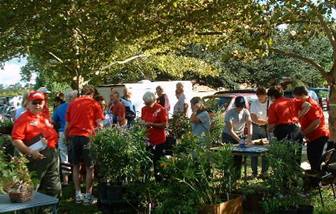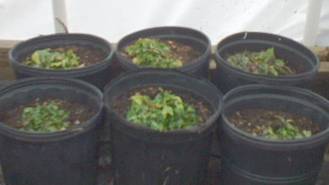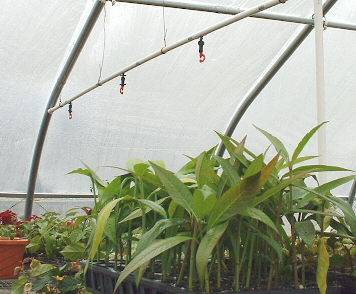Native Plant Propagation Trial-2004 Report
go.ncsu.edu/readext?441630
en Español / em Português
El inglés es el idioma de control de esta página. En la medida en que haya algún conflicto entre la traducción al inglés y la traducción, el inglés prevalece.
Al hacer clic en el enlace de traducción se activa un servicio de traducción gratuito para convertir la página al español. Al igual que con cualquier traducción por Internet, la conversión no es sensible al contexto y puede que no traduzca el texto en su significado original. NC State Extension no garantiza la exactitud del texto traducido. Por favor, tenga en cuenta que algunas aplicaciones y/o servicios pueden no funcionar como se espera cuando se traducen.
Português
Inglês é o idioma de controle desta página. Na medida que haja algum conflito entre o texto original em Inglês e a tradução, o Inglês prevalece.
Ao clicar no link de tradução, um serviço gratuito de tradução será ativado para converter a página para o Português. Como em qualquer tradução pela internet, a conversão não é sensivel ao contexto e pode não ocorrer a tradução para o significado orginal. O serviço de Extensão da Carolina do Norte (NC State Extension) não garante a exatidão do texto traduzido. Por favor, observe que algumas funções ou serviços podem não funcionar como esperado após a tradução.
English
English is the controlling language of this page. To the extent there is any conflict between the English text and the translation, English controls.
Clicking on the translation link activates a free translation service to convert the page to Spanish. As with any Internet translation, the conversion is not context-sensitive and may not translate the text to its original meaning. NC State Extension does not guarantee the accuracy of the translated text. Please note that some applications and/or services may not function as expected when translated.
Collapse ▲This is a 2004 report from a NC Specialty Crops Program Project. It is posted for historical reference purposes.
PROJECT LEADER(S): Tommy R. Grandy, Extension Agent, Agriculture
LOCATION: This trial was located on the southern end of the Peninsula of Currituck County in the township of Harbinger, North Carolina.
IMPACT
Five species of native plants were purchased and then were propagated by cuttings and rooted under a time mist system. Landscapers have an expressed of need for native plant material that can use in our coastal environment, and through this trial to date, the demand for these plants have been excellent. Three species grew very well and 115 of the ones produced were sold the first year. Once stock plant numbers increase, it definitely appears this could a profitable enterprise for nurseries in the business of producing native plants. An educational field day and tour of the propagation trial was held with 22 Master Gardener Volunteers and other quest in attendance. In addition, an activity for 5 Junior Master Gardeners and their 2 leaders was held. The junior Master Gardener heard a presentation on native plants showing their uses and benefits in the environment. They concluded their activity session by actually planting cuttings to be introduced to the time mist system.
INTRODUCTION
Extension cooperator, Sandy Sanders conducted this trial at the site of her nursery located approximately 500 yards from shore line of the Currituck Sound were many wetland plants grow in the natural habitat. Certified stock plants were purchased from a licensed grower and were propagated for sale to local garden centers and landscapers, and stock plants for later production. The plants selected for this trial are: Solidago sempervirens (Seaside Goldenrod), Lobelia siphilitica (Great Blue Lobelia), Eupatorium purpureum (Joe Pye Weed), Amsonia ciliata (Narrow Leaf Blue Star), and Asclepias incarnata (Swamp Milkweed). The trial began with six plants of each species.
Upon receipt in the spring, stock plants were re-potted into three (3) gallon pots and fertilized. Propagation was done by cuttings, and division of at least one species will be done after a full growing season. Spring and summer cuttings were rooted in 50% shade under a timed mist system in cell flats. Once rooted, they were re-potted into two (2) gallon pots and grown to a marketable size. Marketing of plants were and will be wholesale to local garden centers and landscape businesses in the area. Markets are already known for some of the species of plants in this trial. Plans are to add value to these plants through promotion to floral and craft businesses at a later time.
METHODS
The propagation of the different plant species was performed by stem and heal cuttings as well as a few basal cuttings testing both liquid and dry rooting hormone. The cuttings were placed in a small shaded greenhouse and propagated under a time mist system that came on for two minutes every two hours.
RESULTS
The complete results will not fully complete until later this spring, however it is felt that excellent results was produced by this trial.
| Asclepias incarnata : | Sold: | 36 – 2 gallon containers |
| Swamp Milkweed | Stored: | 6 – 3 gallon; 6 – 2 gallon; 32 rooted cuttings |
| Amsonia ciliata: | Sold: | 42 – 2 gallon containers |
| Blue Star | Stored: | 6-3 gallon; 32 – 2 gallon; 64 rooted cuttings |
| Solidago sempervirens: | Sold: | 39 – 2 gallon containers |
| Seaside Goldenrod | Stored: | 6 -3 gallon; 47 – 2 gallon |
| Lobelia siphilitica: | Sold: | None |
| Great Blue Lobelia | Stored: | 6 – 3 gallon; 16 rooted cuttings |
| Eupatorium purpureum: | Sold: | None |
| Joe Pye Weed | Stored: | 3- 3 gallon; 3 – 2 gallon |
CONCLUSION
Propagation: All cuttings responded well to methods used. Success to failure ratio between liquid and dry hormone was insignificant in first round of cuttings, so subsequent cuttings were dipped in liquid hormone for convenience.
Problems: Fertilizer burn occurred with the first fertilizer that was used, so it was replaced, and with subsequent fertilizing, a turf type fertilizer with an anti-burn agent was used.
Milkweed bugs were a definite insect pest problem on the Asclepias during the summer in the nursery, which is next to a swamp or marshland near the Currituck Sound where native milkweed grows. The milkweed bugs were most likely attracted by the concentration of the milkweed in the nursery. However, 18 plants that were moved just a half mile away, did not attract the milkweed bugs. Distance made a difference with this problem.
Public interest: Tours of the nursery and talks about the plants in the project held the interest of the participants and prompted questions primarily about the association of native plants with butterflies and the carefree cultivation of native plants.
Sales: Landscapers and nurseries were eager to present the plants to their customers and reported repeat sales of Asclepias and Amsonia. Wholesale prices for all plants were $5.00 for a 2 gallon container, retail prices varied from $7.50 to $12.00.
Comments: With the dedication of the cooperator, the trial has gone very well, and holds terrific promise during the upcoming spring and summer with more production and sales to come. This was a great learning and educational experience for those involved, and for those people who were able to tour and observe the trial. The Currituck Master Gardener Volunteer experimented with the sale of a few of the donated plants during the fall plant sale. The plants were well received by the public.
TABLES & PHOTOS
Reviewed by Jeanine Davis, NC Alternative Crops & Organics Program, Department of Horticultural Science, NC State University 7/20/2022.






